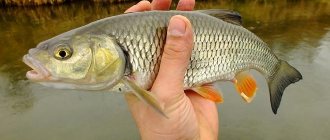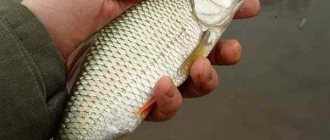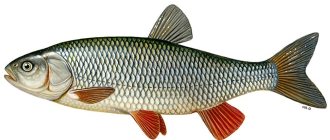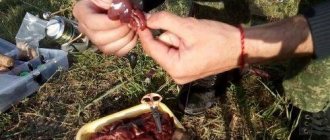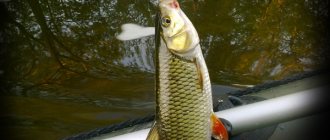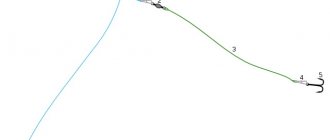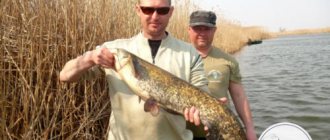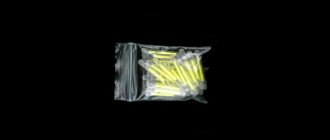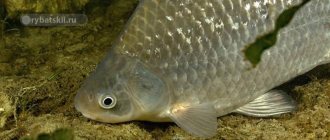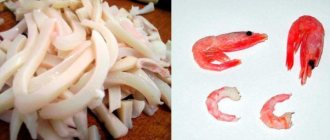In the arsenal of fishermen there are quite a lot of chub baits, which are well known to everyone and have long proven their effectiveness. In addition to natural baits, these also include spinners with wobblers. But there are also catchy baits that few people have heard of and that also need to be paid attention to. One of these attachments is the liver. Let's look at what its advantages are, when to use it and how to use it.
Features of the nozzle, pros and cons
To catch chub, you can use the liver of both birds and livestock.
The most commonly used is chicken or beef. But other options are also suitable - goose, turkey, pork, lamb, and so on. The best choice would be poultry liver, and chicken liver is in first place in terms of catchability. Cattle liver does not attract chub as well, and when fishing for it there will be fewer bites.
What are the advantages of the liver as a bait for chub fishing:
- The main advantage is its aroma, which spreads well in the water and to which the chub does not remain indifferent. Ordinary meat does not have such a smell, so it is inferior to liver in terms of catchability. This bait bleeds in water, which makes it different from maggots, worms and many other baits of animal origin. In addition to chub, catfish respond very well to such bait.
- Liver is one of the best baits for targeted catching of large chub. The likelihood that it will be interested in small fish is not as great as with most other baits used to catch these fish. In addition, the sizes of the pieces that are placed on the hook can be easily varied. If you cut the liver so that they are larger, you can cut off medium-sized chubs.
- Liver suitable for fishing is easy to get at almost any grocery store. In addition, it is quite cheap, it is an economical bait.
- Unlike many other toppings, such as peas or pearl barley, liver does not require any cooking. It is enough to buy it in a store raw and attach it to a hook.
The disadvantages include the fact that the liver is not the best suited for fishing on warm and especially hot days, as well as for catching small chub.
Lure
Especially often when feeder fishing, bait is used to stimulate the fish to approach the casting points of the rigs. Chub baits do not differ in the specificity of their recipes and often consist of adding one animal component to the feeders. For these types of baits, closed feeders with a small mesh are used, which prevents the simultaneous release of food out, and supplies it to the fishing zone gradually and in small quantities. The food used is maggots and bloodworms.
Some fishermen load feeders with mashed black bread soaked in fish oil, adding to it small dung worms torn into pieces, which will continue to move for some time, bloodworms and maggots. For such compositions, feeders with a larger cell are used, allowing the bread to be washed out more intensively and create cloudy, odorous oil stains, collecting predators from large areas of nearby water areas.
It is necessary to take into account that the bait must smell attractive in order to attract fish. When fishing with a feeder rig, the bait is usually placed in a feeder, so the first 6–10 casts are made to attract a catch. For fishing with a float rod, bait is used in the form of balls (possibly of a different shape), which are thrown closer to the float.
When fishing with live bait, the animal's blood, which has coagulated, is suitable for bait. For this purpose, use a sponge or a piece of gauze (bandage). They are soaked in blood, and then fixed to a stone and thrown into the fishing area. In order for the food to acquire its usual bottom color, you need to add a little peat to it. In addition, such an element, due to its plasticity, glues any bait well.
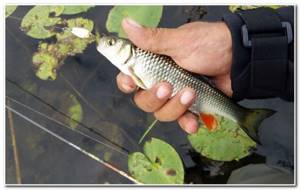
In fishing stores you can purchase ready-made bait in the form of granules. The “Ide-chub” bait is popular. The color, parameters, aroma and taste of the granules attract this predatory fish. It is well suited for fishing in calm rivers.
When to catch chub with liver
The colder the water, the more relevant bait of animal origin becomes. And the liver takes its rightful place among baits for fishing in spring and autumn. In particular, if you know how to find a chub in a pond, you can successfully fish at the beginning of the spring and at the end of the autumn season, when many fishermen think that they don’t bite at all.
Liver is less suitable for summer fishing. However, even during this period it should not be discounted. It can be a great addition to your lure arsenal. But it is better not to use it as the only attachment. In the summer, it is preferable to have other baits with you when fishing, especially of plant origin - peas, corn, and so on. June and August are better for liver fishing than July.
Chub fishing in October
With the arrival of October, and sometimes already in September when weather conditions worsen and the air temperature drops below 10–12 degrees, chubs go into the water column and switch to feeding on fry. There are no easily accessible mayflies anymore and the fish are forced to gain calories by hunting for small bleak in the middle water horizons and for minnows at the bottom.
Feed is increasingly being used to attract fish to bottom fishing spots. The chub bites on the donka throughout the daylight hours. October days for fishing are best selected in clear sunny weather with low wind force.
Liver fishing rigs
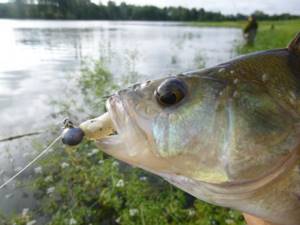
Equipment for catching chub on the liver is divided into 2 groups:
- float;
- bottom
When fishing with a float rod, the simplest installation is also the best: on the main line you need to attach a float, several pellet weights and a leash with a hook. The optimal leash length is about 60 cm.
You can use a mounting with a sliding sinker: it is put on the main fishing line, then the stopper is mounted and the leash is tied with a hook. This option is suitable for fishing in currents and at great depths, when loads weighing 10-15 g or even more are required.
Due to the fact that the installation is sliding, the chub will feel less weight of the sinker when biting.
For bottom fishing it is also better to use a sliding rig. In the feeder, such equipment is called In-line:
- You need to put a sliding sinker on the main line;
- then the stopper;
- tie a swivel;
- Attach a leash with a hook to the swivel.

The optimal weight of the sinker for catching chub with a liver on a donk is about 40-100 g.
You can also use a simple blind bottom installation. But its disadvantage is that the fish will feel the weight of the load when biting. Hair bottom installation is also suitable. But it is rarely used for chub.
Suitable line diameters:
- as the main one - monofilament 0.25-0.35 mm;
- for leashes - monofilament or fluorocarbon with a breaking load of 20-25% less or even thinner, usually 0.15-0.25 mm.
Suitable hook numbers are 6-8, it is preferable to use models with a long shank. Also for fishing with this bait, doubles and trebles of the same sizes are used.
Choosing a fishing spot
With the transition to deep feeding, chubs leave areas with moderate and fast currents, looking for calmer places to stop at the contacts of the main channel jets with the slower flows of backwaters and areas slowed down by the rubble of fallen trees, hydrological and reclamation objects.
Even on small rivers, the fish stay near the cool water in quiet pools and in places shaded by the crowns of trees and bushes hanging over the water. To feed, chubs go to the boundaries of mixing water flows of different speeds, tracking down juvenile fish caught in the stream, frogs and leeches and water beetles picked from algae.
Therefore, casting equipment from behind natural shelters, ensuring the fisherman’s invisibility and accuracy in moving along the coastline in the fishing area, helps to increase the effectiveness of each chub fishing.
A spinning set “tailored” for chub is not cheap. It includes:
- a fairly strong and at the same time light rod, close to ultralight;
- inertia-free reel with smooth running and good laying quality;
- the thinnest but strongest fishing line that can withstand the resistance of hooked fish;
- miniature baits weighing no more than 5 g (usually spinners No0, No1 and wobblers from 2 to 4 cm long).
This river fish loves bodies of water with a current, but it prefers to be in quiet, calm places. A good place to find it is when there is current in different directions. Gear should be thrown at the boundary between such water movements.
We suggest you read: Do you need to cover garlic for the winter?
If in the spring and summer the chub often approaches the banks to search for food, then in the fall it often moves away from it, so it is easier to catch this fish in the fall in a small or medium-sized river. Now there is gear that is easy to throw into the middle of such a reservoir. In small rivers you can find specimens up to 0.5 kg. In large and deep rivers (Don, Volga, etc.) such fish are more difficult to find.
In autumn, chub gather in schools in such reservoirs, and an important point is to find the area where it lives. In this regard, you need to pay attention to channel edges, whirlpools with the movement of water flow in the opposite direction, holes, riffles with a sand and stone bottom. On the shallows, a bigheaded fish can swim out in the daytime if the depth is at least 1 m. The area immediately behind the rifts, where the current decreases slightly, will also be good.
You also need to take a closer look at the steep bank with deep but calm water. If there is still a snag under water near it and bushes with branches going down into the river grow, then most likely there are fish in this place.
You can catch a bigheaded fish in the autumn using a spinning rod, a fishing rod with a float and a donkey. The rod should have a good reel and be fairly strong as the chub will fight back when caught. That’s why you should choose strong gear that can withstand the active resistance of fish weighing up to 5 kg.
Spinning

This fishing tool is relevant in the fall when you have a bombard. This is the name of a transparent float. Wobblers (size 3.5–6.5 cm) or a spinner that rotates are attached to it. The weight of the bombard is selected depending on the depth and distance from the shore in the fishing area. The recommended leash length is at least 1 m.
The chub is a very cautious and timid fish. Not all bodies of water allow you to catch it easily. Frequent habitats of the forehead:
- ponds with stones, various rubble and bushes;
- shady places in the summer, where many other representatives of aquatic fauna teem;
- changes in depth, as well as a change from a fast current to a calm one, and vice versa;
- riffles and barriers, like dams and dams.
Pike perch also choose a similar habitat - just like the chub, they choose places where they can hunt and hide.
Successful chub fishing is a consequence of choosing the right fishing rod. Which spinning rod to choose for this fish depends on the behavioral characteristics of the fish.
Light tackle performs well on reservoirs. But classic and ultralight are not popular options for catching chub, since they do not allow for long casting like light. And when catching a chub, this is important, because timid individuals do not allow strangers, spinners, to get close to them. Wobblers and spinners should also fit perfectly into the gear.
How to prepare your liver for fishing
The best bait for catching chub is fresh raw liver. Thus, the bait purchased in the store only needs to be cut into portioned pieces that can be conveniently placed on the hook.
These can be cubes with an edge of 2 cm or strips. You can also cut the liver while fishing. The advantage of this option is that pieces of liver placed on a hook will bleed better. Important! During fishing, the liver on the hook should be changed more often.
The more blood a piece sent into the water produces, the better. A fresh piece of liver, just placed on a hook, bleeds the most, which attracts chub very well. A bait that has managed to get wet in water and no longer produces blood works much worse. The more passive the fish, the more often you need to change the bait. You can also pour boiling water over this bait or boil it a little. After this, it will stay on the hook better. The simplest and most effective method of processing is to immerse the bait in boiling water for 2 minutes. But cooked liver stops giving blood and loses much of its aroma and taste.
There is another interesting option for preparing the liver for fishing - grind it in a blender and mix it with flour. The result will be a red dough that can be molded into small balls to be placed on a hook.
Chub fishing in September
September is famous for its excellent chub bite. The fish fatten, actively feeding, collecting food in the surface layers of the reservoir. Chub fishing continues with fly fishing and float rods both from the surface and in the water column. The fish still hang on to the currents near trees hanging over the water and steep banks. The main component of its diet remains insects that fall on the water.
Sunny and calm weather with high atmospheric pressure activates the bite. Rain and cold weather reduce the feeding activity of the predator.
How to preserve your liver while fishing
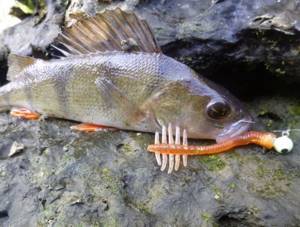
But, if there is no heat, it is usually enough to simply place the liver in an open container in the shade. It’s even better to place it in a hole dug in clay, where the temperature will be lower.
Important! The liver should not be exposed to the sun. When exposed to sunlight, it acquires the consistency of jelly, after which it becomes almost impossible to use it as bait.
You can also make ice at home, place the cubes in a container, and put a bag of liver on top. Ice will also be good for storing bait in a thermos.
Lures
In autumn chub fishing, strong fishing rods are often used, the length of which depends on whether you are fishing from a boat or from the shore. In any case, it is necessary to carefully study the bottom of the reservoir in order to throw the sinker with the hook and bait as deep as possible, and, based on this, choose the optimal length of the fishing line. In addition, pay attention to the choice of float - it should not be too long and bright so as not to scare away cautious fish.
In late autumn, in bright and sunny weather, chub can also bite on a spinning rod. Small (00, 0, 1 or 2) sized spinners are selected as bait. If the river is wide and deep enough, then in October and November you can use jig baits no larger than 4 cm in size.
Photo 3. Chub and a box of bait.
Vibrotail and twister of natural, dim colors have proven themselves well in autumn chub fishing. You need to start casting with them, and if smooth casting does not produce results for a long time, gradually change them to brighter ones (green and yellow).
During active feeding, fish may be attracted by a rotating spoon with a noise effect. There are many debates about the use of such bait, but the undeniable fact is that chub actually react more often to such lures during the autumn feeding period.
This is true for the summer, but from the end of September there are no longer bugs on the surface, small fish also appear rarely, so it is better to fish from the bottom, using a small minnow as bait. You can fish with live bait either with a donkey or with a fishing rod. Each of these tackles must be adjusted so that the gudgeon is above the bottom at a height of up to 20 cm. You cannot lower the live bait too low, otherwise it will try to hide in the mud or behind some obstacle.
Since it is not easy to get hold of minnows in the fall, summer live and non-living baits are often used: amphipods, caddis flies, maggots and other larvae, steamed cereal grains, dough, bread. Unfortunately, all of the baits listed have one significant drawback - they mainly catch small specimens. Therefore, for targeted catching of trophies, many fishermen use spinning rods.
We invite you to familiarize yourself with strawberry processing in the fall, how to properly
Chub involves the use of a wide variety of baits:
- small silicone twisters;
- vibrotails;
- wobblers;
- microscrapers;
- rotating spoons.
Among fishermen there will be fans of any one type of bait. Many years of experience show that catching chub with a spinning rod brings the best results using wobblers. And you need to choose spinning rod models specifically for chub.
How to attach a liver to a chub hook
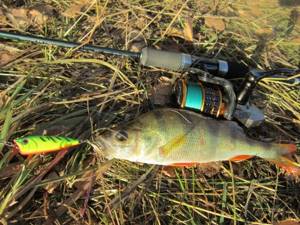
But there are planting methods that allow you to avoid such troubles. On the other hand, in many cases it is enough to simply put the bait on the hook, and special strength of the “installation” is not needed. Generally, each fisherman has his or her own favorite liver rigging method for each fishing situation.
It is enough to know the five main options to be able to choose from them:
- You can cut off a larger piece of liver and place it in such a way that the entire hook is inside, and only a small part of the forearm with the eye sticks out. With this option, the bait is held quite securely. In addition, thanks to the use of a volumetric nozzle, fines can be cut off. Since the sting is hidden inside the bait, the likelihood that a large, cautious chub will prick itself during a bite, get scared and throw the hook, is minimized. This method of baiting is especially suitable for situations where the chub is passive.
- Another option is to use a tee instead of a regular hook. The optimal size for catching chub is about 8. The liver must be placed in such a way that it is put on each of the three stings, this ensures a very reliable fixation. The points should remain open. In contrast to the previous option, this method of baiting is better suited for catching active chub. In addition to tees, doubles can be a good replacement for single hooks.
- After placing it on the hook, you can tie the liver with a thread. It is better to match it to the color of the bait so that it does not stand out visually. The thread is simply wrapped around a piece of the liver so that it is securely tied to the forend. You shouldn't expect a good result on the first try; you need a little practice to learn how to do it correctly.
- Another way is to place the liver in a piece of women's stockings, and then tie it with thread, making a kind of pouch. This option is used when fishing with a hair rig, which is relevant for hunting large chub.
- If liver in the form of dough is used as bait, you need to make balls from it and put them on hooks. The nozzle will hold much better on a tee, but a double or single will also work.
Winter fishing technique
Organization of chub fishing is simple. When going to a familiar body of water, you need to prepare holes in places of turbulence and whirlpools in coastal dumps before 10 a.m. If you are fishing with a float tackle, we drill 2-3 holes in a row. We add fertilizer and monitor the behavior of the floats.
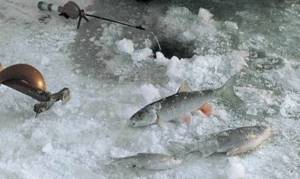
With a jig - more active fishing. Each hole is fished at all depths. Retrieving is a slow rise with frequent tapping of the rod on the hand. If there are no bites, we sharply raise the fishing rod by 500–600 mm to attract the attention of the predator. Having made 3-4 postings and not waiting for bites, we change the hole.
Every fisherman who catches chub in one place already knows the catch spots and fishes for them first. You can add complementary foods. During this time, it must contain animal supplements.
If bloodworms and maggots are used as bait, the bait is made from various cereals, and additionally chopped worms and flavorings with the taste of crustaceans, garlic and other flavorings are added. If you put a fry on the hook, you will need to soak the gauze with the blood of any animals or ground liver and lower it into the water on the line.
In severe frosts, it makes no sense to go looking for chub; at this time, the fish slides into deep holes with gushing springs and, possibly, will bite if the bait drops in front of its nose. During the deep winter period, the activity of the fish decreases, it stops responding to fry and moving baits. This is a time of calm in the activity of all types of underwater inhabitants.
Only long thaws can activate the fish.
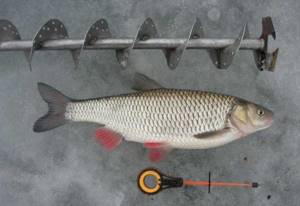
How does a chub take it?
Let us remind you: the chub is a very cautious fish, so you need to remain quiet on the ice. The predator’s bite is unexpected, without long twitches. But she takes the bait very carefully, and the bite is hard to notice. The nod bends sharply during a pause in the retrieve, which means you need to smoothly and lightly hook the fish and enjoy active resistance when fishing.
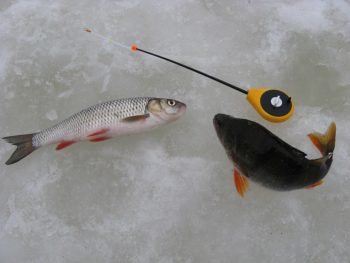
When bringing prey to the ice surface, it is better to cover the hole with your body and use a hook to pull out large specimens.
In conclusion, some advice from experienced fishermen.
When going to a pond, choose places without snags and stones sticking out of the water. Consider current speed and eddies, time of year and size of prey when choosing equipment.
But in any case, fluorocarbon should not be used as the main line - such equipment breaks off when the first worthy opponent is caught.
The hole does not need to be cleared of snow and ice crumbs; it is enough to leave a small hole for the line to pass through when trolling. Do not use fashionable luminous spinners and floats as bait, such equipment will scare away the fish.
The most important. The first ice and melting ice in early spring are very dangerous, so remember the rules for walking on thin ice, always have a ball of rope in your box and spread your arms wide if you go under the ice.
Follow these simple rules and recommendations and catch trophy chubs. Good luck fishing.
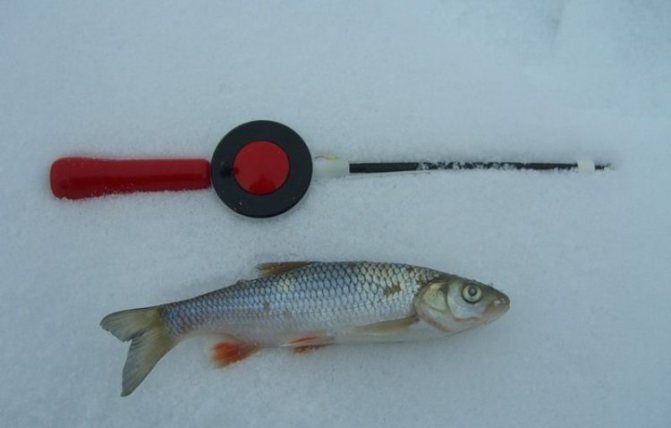
What do you need for winter chub fishing? You will need: Ice drill, winter fishing rod, fishing line, spoons, jigs, floats, as well as a fishing box for storing fishing rods and other accessories. Important: don’t forget to buy thermal underwear. Any fishing will be a pleasure in it!
